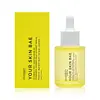What's inside
What's inside
 Key Ingredients
Key Ingredients

 Benefits
Benefits

 Concerns
Concerns

 Ingredients Side-by-side
Ingredients Side-by-side

Water
Skin ConditioningGlycerin
HumectantKojic Acid 1%
AntioxidantXanthan Gum
EmulsifyingPhenoxyethanol
PreservativeGlycolic Acid 0.5%
BufferingPersea Gratissima Fruit Extract
EmollientGlycyrrhiza Uralensis Root Extract 0.3%
Skin ConditioningButylene Glycol
HumectantSodium Bisulfite
AntioxidantSodium Hydroxide
BufferingEthylhexylglycerin
Skin ConditioningTetrasodium EDTA
Propanediol
SolventBacillus/Soybean Ferment Extract
Skin Conditioning1,2-Hexanediol
Skin ConditioningCitric Acid
BufferingLactic Acid
BufferingNelumbo Nucifera Flower Extract
Skin ConditioningPrunus Mume Fruit Extract
HumectantDisodium EDTA
Water, Glycerin, Kojic Acid 1%, Xanthan Gum, Phenoxyethanol, Glycolic Acid 0.5%, Persea Gratissima Fruit Extract, Glycyrrhiza Uralensis Root Extract 0.3%, Butylene Glycol, Sodium Bisulfite, Sodium Hydroxide, Ethylhexylglycerin, Tetrasodium EDTA, Propanediol, Bacillus/Soybean Ferment Extract, 1,2-Hexanediol, Citric Acid, Lactic Acid, Nelumbo Nucifera Flower Extract, Prunus Mume Fruit Extract, Disodium EDTA
Ingredients Explained
These ingredients are found in both products.
Ingredients higher up in an ingredient list are typically present in a larger amount.
Glycerin is already naturally found in your skin. It helps moisturize and protect your skin.
A study from 2016 found glycerin to be more effective as a humectant than AHAs and hyaluronic acid.
As a humectant, it helps the skin stay hydrated by pulling moisture to your skin. The low molecular weight of glycerin allows it to pull moisture into the deeper layers of your skin.
Hydrated skin improves your skin barrier; Your skin barrier helps protect against irritants and bacteria.
Glycerin has also been found to have antimicrobial and antiviral properties. Due to these properties, glycerin is often used in wound and burn treatments.
In cosmetics, glycerin is usually derived from plants such as soybean or palm. However, it can also be sourced from animals, such as tallow or animal fat.
This ingredient is organic, colorless, odorless, and non-toxic.
Glycerin is the name for this ingredient in American English. British English uses Glycerol/Glycerine.
Learn more about GlycerinPhenoxyethanol is a preservative that has germicide, antimicrobial, and aromatic properties. Studies show that phenoxyethanol can prevent microbial growth. By itself, it has a scent that is similar to that of a rose.
It's often used in formulations along with Caprylyl Glycol to preserve the shelf life of products.
Sodium Bisulfite is an antioxidant and is a preservative.
Sodium Hydroxide is also known as lye or caustic soda. It is used to adjust the pH of products; many ingredients require a specific pH to be effective.
In small amounts, sodium hydroxide is considered safe to use. However, large amounts may cause chemical burns due to its high alkaline.
Your skin has a natural pH and acid mantle. This acid mantle helps prevent harmful bacteria from breaking through. The acid mantle also helps keep your skin hydrated.
"Alkaline" refers to a high pH level. A low pH level would be considered acidic.
Learn more about Sodium HydroxideTetrasodium EDTA is the salt formed from neutralizing ethylenediamine tetraacetic acid with sodium hydroxide. It is a chelating agent and used to prevent metal ions from binding to other ingredients. This helps keep the product and ingredients stable.
Tetrasodium EDTA comes as a white solid and is soluble in water.
Water. It's the most common cosmetic ingredient of all. You'll usually see it at the top of ingredient lists, meaning that it makes up the largest part of the product.
So why is it so popular? Water most often acts as a solvent - this means that it helps dissolve other ingredients into the formulation.
You'll also recognize water as that liquid we all need to stay alive. If you see this, drink a glass of water. Stay hydrated!
Learn more about WaterXanthan gum is used as a stabilizer and thickener within cosmetic products. It helps give products a sticky, thick feeling - preventing them from being too runny.
On the technical side of things, xanthan gum is a polysaccharide - a combination consisting of multiple sugar molecules bonded together.
Xanthan gum is a pretty common and great ingredient. It is a natural, non-toxic, non-irritating ingredient that is also commonly used in food products.
Learn more about Xanthan Gum